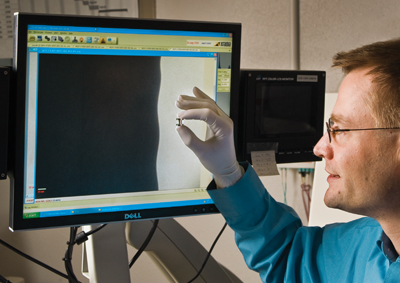Sandia images the sea monster of nuclear fusion: the Rayleigh-Taylor instability
By Neal Singer

Researchers at Sandia’s Z machine this summer applied a new X-ray imaging capability to take pictures of a critical instability at the heart of the huge accelerator. The pictures may help remove a major impediment in the worldwide, multidecade, multibillion dollar effort to harness nuclear fusion to generate electrical power from seawater.
BUT IS IT ART? Dan Sinars examines one of the aluminum cylinders used in the Z pulsed power experiments. The monitor on the X-ray machine in the background displays a highly-magnified, pre-experiment view of the wavering edges machined into the outside edge of the cylinder. These were used to intentionally start the growth of the instability. (Photo by Randy Montoya)
“These are the first controlled measurements of the growth of magneto-Rayleigh-Taylor [MRT] instabilities in fast Z-pinches,” says project lead Daniel Sinars (1643).
MRT instabilities are spoilers that arise wherever electromagnetic forces are used to contract (pinch) a plasma, which is essentially a cloud of ions. The pinch method is the basis of the operation of Z, a dark-horse contender in the fusion race.
A pinch contracts plasma so suddenly and tightly that hydrogen isotopes available from seawater, placed in a capsule, should fuse.
That’s the intent. Instead, the instability crimps the cylindrically contracting plasma until it resembles a string of sausages or shreds the plasma into more fantastic, equally useless shapes. This damaged contraction loses the perfect symmetry of forces necessary to fuse material.
Fast pinches at Z, which take place in less than 100 nanoseconds, already have produced some neutrons, a proof of fusion. But a major reason not enough neutrons have been produced to provide a source of peacetime electrical power is the MRT instability.
Dan led seven experimental shots to map the disturbance. The experiments were motivated by a concept proposed last year by Steve Slutz (1644). Traditionally, scientists would use an array of spidery wires to create a compressed, X-ray-generating ion cloud. The X-rays were then used to compress fusion fuel. Steve suggested instead that the magnetic pinching forces could be used to directly fuse fuel by compressing a solid aluminum liner around fusion material preheated by a laser.
Because the new concept would not produce X-rays as a heating tool but instead relied on directly compressing the fuel with magnetic pressure, the MRT instability was the primary threat to the concept.
“Once we started looking at solid liners, it was easy to conceive of doing a controlled experiment to study the growth of the instability,” says Dan.
This is because experimenters could etch solid tubes to whatever degree they desired to provoke the instability. Accurate etching is not an option with fragile wire arrays.
The MRT problem occurs because even minute dips in a current-carrying surface — imperfections merely 10 nanometers in amplitude — can grow exponentially in amplitude to millimeter scales. In the experiments by Dan and others, the tubes were scored with a sinusoidal perturbation to intentionally start this process.
“The series of pictures over a time scale of 100 nanoseconds brought the life of the MRT into focus,” says Dan.
Previously, competing computer simulation programs had given conflicting predictions as to the extent of the threat posed by the MRT instability, leaving researchers in the position, says Dan, of “a man with two watches: he never really knows what time it is.”
The more accurate simulations will enable researchers to better tweak the conditions of future Z firings, more effectively combating the effect of the instability.
Researchers believe that with thick liners and control of the MRT, Z could achieve an output of 100 kilojoules to match the 100 kilojoules input to the fuel to start the fusion reaction. “That would be scientific breakeven,” says Dan. “No one has achieved that.”
But that day, he says, may be just two to three years away.
The work is reported in a paper in the Oct. 29 issue of Physical Review Letters and was the subject of Dan’s invited talk on Nov. 17 at the APS Plasma Physics meeting in Chicago. The work was paid for by Sandia’s Laboratory Directed Research and Development program and DOE.